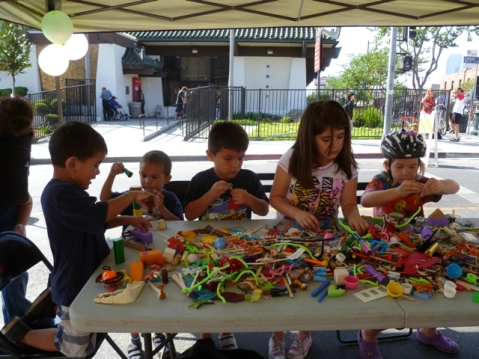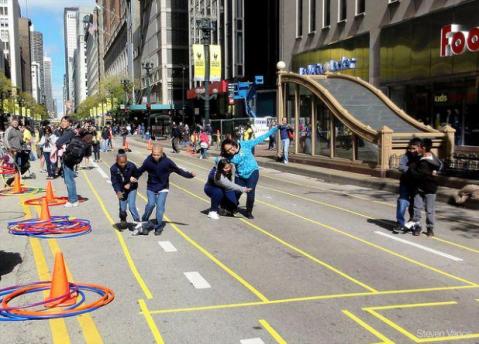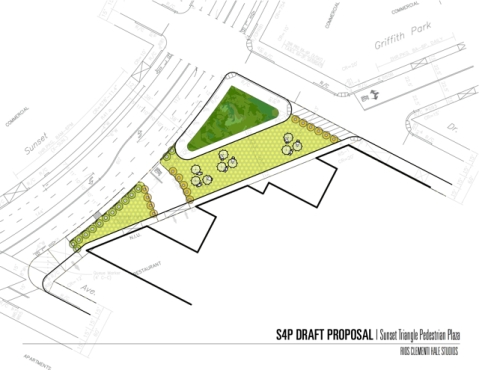CicLAvia’s Play Street
One of my favorite events in Los Angeles is CicLAVia, a bi-annual event that closes around 10 miles of streets to cars, filling them with bicycles, food trucks and fun. And every year it is equally as amazing to see Los Angeles’ wide boulevards filled with bicycles and pedestrians enjoying the streets and experiencing Los Angeles in an entirely new way.
The origin of CicLAvia is Ciclovía from Bogotá, Colombia. Bogotá has inspired many innovative transportation planning projects here in the US but the idea of Ciclovía or “open street” projects may be most popular. These projects can be truly transformative because they allow anyone to experience what our largest public space could be like if it prioritized people instead of cars. The Open Streets Project has created a comprehensive database of projects in almost every state in the country. From New York to Fargo to San Antonio, residents can enjoy lively open streets filled with the rush of people instead of cars
For October’s CicLAvia, some friends and I from the Living Streets Los Angeles volunteer committee, decided to take over a side street along the CicLAvia route in Los Angeles’ Chinatown and turn it in to a street filled with playful activities. Our inspiration for our play street came from the incredible work of urban planner and artist Candy Chang. Ms. Chang transforms public space through engaging participatory art projects that allow residents to use their imaginations to dream of what spaces can become.

“I Wish This Street Was…” presented by Living Streets Los Angeles at CicLAvia. Photo by Living Streets Los Angeles

Children design their ideal street at “I Wish This Street Was…” presented by Living Streets Los Angeles at CicLAvia. Photo by Living Streets Los Angeles

Photo booth fun at “I Wish This Street Was…” presented by Living Streets Los Angeles at CicLAvia. Photo by Living Streets Los Angeles

Children painting with their parents for “I Wish This Street Was…” presented by Living Streets Los Angeles at CicLAvia. Photo by Living Streets Los Angeles

Photo booth fun during “I Wish This Street Was…” presented by Living Streets Los Angeles at CicLAvia. Photo by Living Streets Los Angeles

Community members envision a new use for a street in Los Angeles (based on “I Wish This Was…” by Candy Chang). CicLAvia, Los Angeles. Photo by Living Streets Los Angeles.

Community members envision a new use for a street in Los Angeles (based on “I Wish This Was…” by Candy Chang). CicLAvia, Los Angeles. Photo by Living Streets Los Angeles.
Chicago’s Celebration in the Streets
Look at all the fun to be had at this year’s Open Streets Chicago event!
Inexpensive transformations of our largest public spaces (our city streets) turn concrete slabs built for cars into playgrounds for the entire city.
Check out more photos from this event here.
Beach Party on Eagle Street
The Eagle Street Beach Party, a free event which started in 1999, is organized by the North Adams Office of Tourism and Cultural Development. Local vendors give away prizes for creative sand castles an sculptures, and food and music cap the day.
Sunset Triangle Plaza
Cities like New York and San Francisco have lead the way in the transformation of our largest public space, our city streets. They have successfully created comfortable, vibrant and welcoming public plazas constructed efficiently and inexpensively by using paint and temporary materials. These plazas can help calm traffic (decreasing incidents of pedestrian and cyclist injury and fatality), encourage walking and cycling (contributing to personal and public health through exercise and the decrease of carbon emissions from cars), and can benefit local businesses (because when you create an attractive space, people are more likely to linger and patronize nearby shops and restaurants.
The hallmarks of these public spaces are their location (converting redundant or wide streets in areas that already have high levels of commercial, pedestrian or cyclist activity), their customizable nature (moveable seating and chairs are always preferable because you can feel comfortable to sit alone or in large groups), and their accessibility (no stairs, adjacent to crosswalks and sidewalks, lots of seating options, shade and visibility).
Los Angeles, with it’s warm weather, wide boulevards and high levels of pedestrian activity in certain neighborhoods could be a perfect playground for these types of public spaces. Last year the Los Angeles Department of Public Health received a grant to decrease obesity rates in Los Angeles and together with the Department of City Planning, they decided to put that money towards Los Angeles’ first street-to-plaza conversion project.
This particular location was chosen because a) the community had been asking for a pedestrian plaza in this area for over 10 years, b) there was already a twice-weekly farmer’s market in this location so the street already had consistent pedestrian activity; and c) as previously mentioned, the street is redundant and sandwiched between a small triangular park and popular businesses whose patrons were usually crowding the tiny sidewalks with bicycles and belongings.
Sunset Triangle Plaza is a one-year pilot project. Early next year community members, city agencies and elected officials will determine whether or not the plaza will become something more permanent or be converted back in to a street.
Street-to-plaza conversion projects can be hard to visualize if you’ve never seen or experienced one before. The wonderful thing about creating temporary demonstration projects is that they allow a city to inexpensively transform public space so residents can see for themselves just how transformative these types of spaces can be.
Sunset Triangle Plaza from Streets for People on Vimeo.










